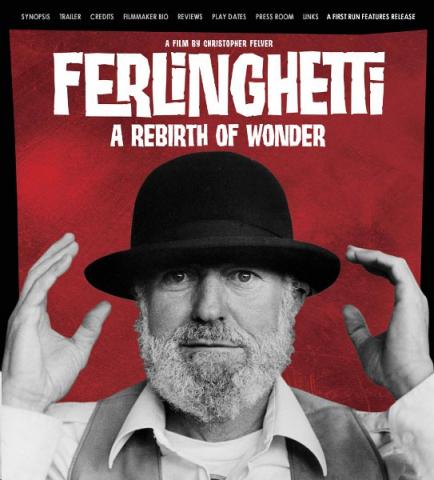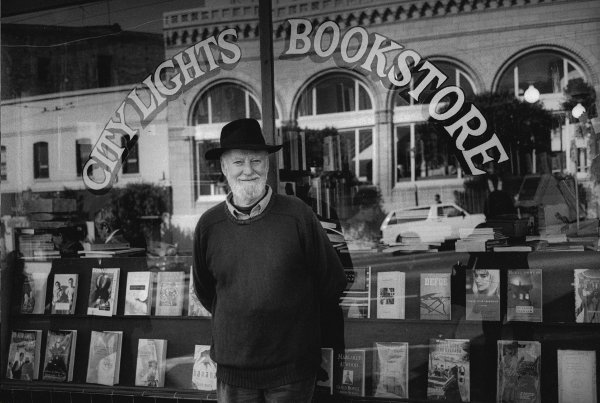‘Ferlinghetti: A Rebirth of Wonder’ Pays Homage to a Literary Icon

More than 60 years after Jack Kerouac’s On the Road ushered in a new generation of young writers, the rhythm of the Beat Generation continues to pulse through the veins of American literature. One man who keeps the tempo going is Lawrence Ferlinghetti. The poet, painter, political revolutionary and publisher extraordinaire is best known for A Coney Island of the Mind, and for his bookstore and publishing house, City Lights, at the corner of Green and Grant in Bohemian North Beach, San Francisco.
These achievements would be more than enough to put him on the map of American scholarship, but his legacy as a free speech supporter, champion of original writing, and proponent of radical political thought have spread his influence beyond the beat poets that he nurtured. Christopher Felver’s Ferlinghetti: A Rebirth of Wonder is a jazzy tapestry of a documentary, tracing the man’s life from his chaotic beginnings to his World War II experiences to his patronage of the counterculture and beyond. It’s a lively and illuminating ride that brings the radicalism of the 1950s and 1960s to life and showcases the lasting impact Ferlinghetti’s vision has had on literature today.
Felver has rich source material to pull from, and he makes good use of it: engaging photos, videos, news clippings and the usual talking-head footage are all set to a jazz soundtrack that keeps things dancing along. There are photographs of his childhood years, and news reels of the storming of Normandy and the heartbreaking aftermath of an atom-bombed Nagasaki (an experience that made Ferlinghetti a lifelong pacifist). Great names in the arts and letters of the 1960s—Dennis Hopper, Michael McClure, Amiri Baraka, Gary Snyder, Anne Waldman, Jack Hirschman—weigh in on how the man and his bookstore made San Francisco the center of literary culture. And then there are the poetry readings, by Ferlinghetti himself, Bob Dylan, and the late Allen Ginsberg. Decades after their conception, these works have lost none of their power and continue to jolt and inspire.
Much attention is paid to the publication of Allen Ginsberg’s seminal Howl in 1956. The obscenity trial that ensued resulted in a landmark decision in favor of the First Amendment and freedom of speech that would change publishing irrevocably. The case led the way for other provocative literature to be printed in the United States. Classics such as Lady Chatterley’s Lover and Tropic of Cancer may never have been published without Ferlinghetti blazing the trail.

As told by the writers, artists and poets who were Ferlinghetti’s contemporaries, City Lights was more than just a bookstore. It became the center of intellectual life in San Francisco, and possibly even the world. “Every artist and anarchist would come through at some point,” recalls journalist Robert Scheer. Poet Billy Collins likened Ferlinghetti’s approach to “rolling a grenade into the library and breaking tradition.” People would come to read and discuss the literature and politics of the day. City Lights published and stocked works on anarchy, socialism, feminism, deep ecology, translations and international fiction—titles that had no outlet anywhere else. By mixing old footage with contemporary, we see that the City Lights tradition continues today.
This documentary is filled with delectable nuggets: Ferlinghetti’s readings, of course. Scenes with George Whitman, founder of Shakespeare & Co. in Paris (City Lights was founded as something of a sister bookstore). A wry discourse on the “roll” of artists (hot cross bun or delicate croissant). Reminiscences of Jack Kerouac and Allen Ginsberg. A screed against the National Endowment for the Arts, which Ferlinghetti believes makes artists co-conspirators with a corrupt government. And through it all, the poet’s 94-year-old voice rings loud and clear—resigned to the imperfections of the world, the failure of the left, the destroyed environment; and yet hopeful for a future where the artists rise up and usher in a new era of sociopolitical change. He continues to await the rebirth of wonder.
Author Bio:
Nancy Lackey Shaffer is a contributing writer at Highbrow Magazine.
To purchase this DVD, visit www.firstrunfeatures.com































































































































































































































































































































